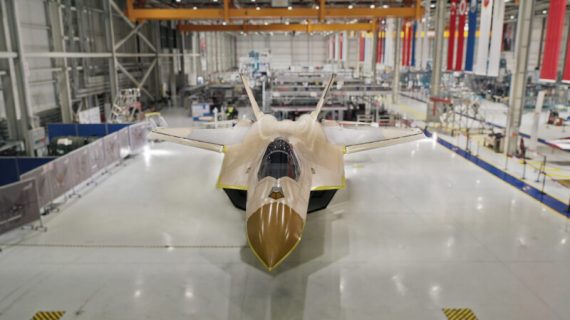M
arch 11, 2023 was the 35th anniversary of a significant event in the history of Turkish defense and aerospace industry: on that day, the first Turkey-assembled F-16C Fighting Falcon combat aircraft was delivered to the Turkish Air Force (TurAF) by TUSAŞ Aerospace Industries (TAI).
TAI was established in 1984 as a joint venture between General Dynamics (later to become Lockheed Martin) and Türkiye Uçak Sanayii A.Ş. (TUSAŞ), for the manufacture of the F-16 aircraft. To produce the engines, another joint venture between General Electric and TUSAŞ was formed under the name of “TUSAŞ Engine Industries” (TEI). The first eight American-built F-16s were delivered in 1987.
Over the course of 35 years, TAI became a national company, with the acquisition of Lockheed Martin’s shares and the consolidation of the two companies, TAI and TUSAŞ under Turkish Aerospace Industries (Türk Havacılık ve Uzay Sanayii AŞ, TUSAŞ). Turkish Aerospace has manufactured a total of 308 F-16s: 262 for the TurAF and 46 for the Egyptian Air Force. In addition, Turkish Aerospace upgraded F-16s of the TurAF and Jordanian and Pakistani Air Forces. Based on ever-expanding infrastructure and experience, Turkish Aerospace initiated many indigenous and international programs.
Now, on the 35th anniversary of the delivery of the first indigenously manufactured F-16 fighter jet, Turkish Aerospace is preparing for another major milestone: the rollout of the first prototype of the Milli Muharip Uçak (MMU, National Combat Aircraft).
Turkey’s MMU (National Combat Aircraft)
The MMU is envisaged as incorporating many state-of-the-art technologies and capabilities such as very low observability, advanced sensors, and data-link systems as well as the capability to carry a wide range of guided weapons, all of which are characteristic features of fifth-generation combat aircraft such as F-22, F-35, J20, and Su57. The MMU’s abilities will be further enhanced through extensive use of artificial intelligence (AI) and neural networks (NN).
The MMU program consists of four main phases: Conceptual Design, Design and Prototype Qualification, Initial and Full Operation Capability, and Serial Production. The first phase, with the assistance of Sweden’s Saab Automobile started in 2011 and was completed in 2013. A contract for the first stage of the second phase, namely Engineering Development and Preliminary Design (ED&PD) was signed between the Turkish Presidency of Defence Industries (SSB, Savunma Sanayii Başkanlığı) and Turkish Aerospace in August 2016. Following this, Turkish Aerospace signed a contract with BAE Systems for consultancy and technical assistance in 2018. The project’s schedule officially started in September 2018.
The first stage of the second phase is planned to last for four years, and it will be followed by the second stage, Critical Design and Prototype Qualification, which is expected to last a total of eight years.
The program is currently in the ED&PD phase. Turkish Aerospace plans to roll out the first prototype in April 2023 with the maiden flight planned for the end of the same year. Service entry will take place in the late 2020s; the MMU is planned to form the backbone of the TurAF combat fleet, operating until around 2070.
Drone revolution
The remarkable operational and export successes of Turkish drones have made Turkey a major player in this field. More than 30 countries use Turkish drones such as Bayraktar TB2, Bayraktar Akinci, ANKA, and AKSUNGUR. The two leading Turkish drone manufacturers, Turkish Aerospace and Baykar Technology, are currently working on jet-powered combat drones, namely the ANKA-3 and the Bayraktar Kızılelma, respectively.
Both platforms will form the backbone of the TurAF drone strike capability. The ANKA-3 is expected to perform missions alongside the MMU, as a “loyal wingman,” whereas the Kızılelma will also be able to be operated from the TCG Anadolu amphibious landing ship with its short takeoff and landing capability.
Future plans
Turkey’s removal from the F-35 project because of the acquisition of the S-400 air defense system from the Russian Federation directly affected the TurAF’s modernization plans. The TurAF previously planned to operate the F-35 alongside the modernized F-16 fleet, which would later be replaced by the MMU. The MMU program, in its early stages, called for the development of an air superiority fighter. Strike missions would be undertaken by the F-35.
The elimination of the F-35 from the road map forced Turkey to redraw these plans and focus on a true omnirole capability for the MMU, employing a wide range of air-to-air and air-to-ground weapon systems, all developed or under development by Turkish companies. The F16 fleet, through the indigenous avionics upgrade under the Özgür program, will see an extended period of service. Additionally, Turkey’s request of 40 F-16Vs and upgrade kits for 79 aircraft is important for filling the potential capability gap until the full operational capability of the MMU fleet.
Recommended
Time is of the essence for the TurAF. Almost all neighboring countries have been allocating significant resources to upgrade their air forces: Greece is taking delivery of Rafale fighters from France and upgraded F-16s from the United States, and Israel is operating more than 30 F-35s and has recently announced acquisition plans for the advanced F-15EX fighter. Meanwhile, Egypt is operating the Rafale, MiG-29SMT, and is currently in negotiations with South Korea for the license production of the FA-50 light combat aircraft. And, Iran has recently reportedly taken delivery of 24 Su-35s, which were originally produced for Egypt.
The MMU program, therefore, has become even more crucial. First, it will be the main asset for the sustained qualitative superiority of the TurAF. Second, it will allow the TurAF and Turkey to achieve operational independence in the air domain. And third, it will enable a large defense and aerospace industry base to evolve around Turkish Aerospace, which in turn will be needed to develop even more challenging programs.





